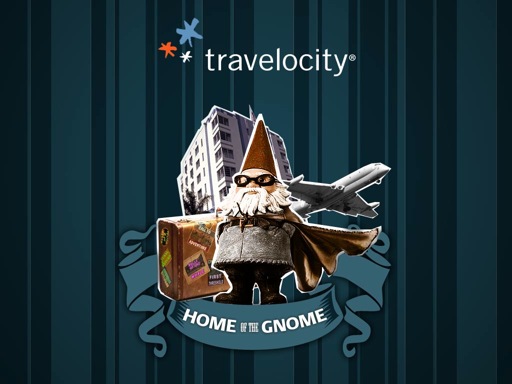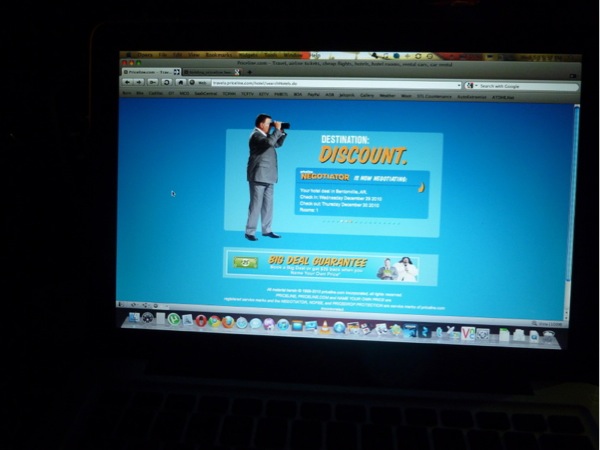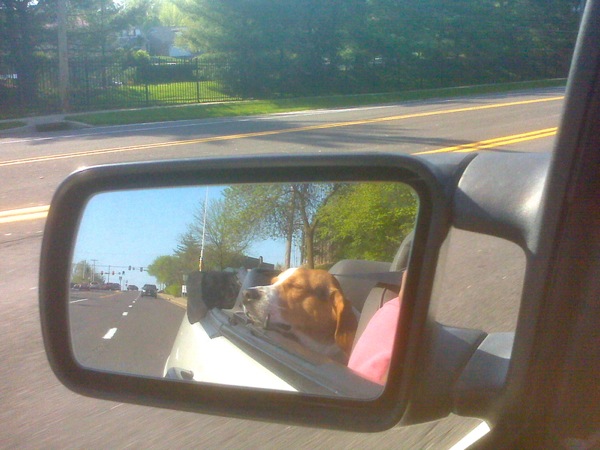



Just a few years ago, finding a hotel on the road meant pulling into a small town, walking up to the front desk, and chatting with the clerk about the price. If you wanted to save money, you had to join AAA and find a coupon book at a truck stop or rest area.
Even with travelers clubs and discounts, there were no promises of quality. You could crawl into a bed and doze off blissfully only to wake up to a cold shower. You could wake up in the middle of the night to the sound of bikers next door plowing mercilessly on the other side of a poorly insulated wall. Without online reviews and booking services, you had less accountability. Travelers are, after all, temporary visitors, so a dissatisfied customer was unlikely to linger around town telling everyone how awful their stay was.
Seedy hotels haven’t gone away, but Priceline and Travelocity help manage the risk and cut costs dramatically.
Priceline and Travelocity handle payments and reservations, interfacing with the hotel for current pricing and availability. Both sites offer reviews, photos, and ratings and both sides have a bidding or bid-like process. For direct listing and booking, they’re both the same. For bidding, they’re quite different.
You know about Priceline from the ads featuring Captain Kirk, known on Boston Legal as Denny Crane or on Rescue 911 as William Shatner. Whatever you call him, he’s a fat old man with more personality than he knows what to do with. They call him the negotiator. He’s seen in advertisements shaking down hotel clerks for lower prices with his trademark anti-charm.
Travelocity has a gnome mascot which hasn’t really caught on. I know roam rhymes with gnome, but that’s the only connection I’m getting.

I don’t get it. He looks like Verne Troyer with goggles and a beard.
Here’s how the bidding process words on Priceline:
The process is blind. You’re getting a deal because you don’t know what hotel you’re going to get. All you know is the expected level of amenities and the part of town you’re going to end up in. The rest is all up to chance, sort of.
If your bid isn’t accepted by any hotels, you’ll be asked to do the following:
Occasionally, Priceline will drop hints, like “Your bid of $40 is unlikely to be accepted based on recent history” or “If you increase your bid by $5 you have a strong chance of bidding successfully.” If you log out and reattempt the exact same bid criteria but with only a higher price, Priceline may recognize you and force you to edit your bid or lock you out temporarily.
All of this is a shot in the dark. And when you’re on the road with your laptop and cell phone in some dimly lit rest area on a crappy connection, you’re eager to get done and get going.

Bidding in progress. I’m parked at a gas station east of Dallas tethering my Mac to my Blackberry.
The workaround to all of this is to use a Priceline or Hotwire reporting site like BetterBidding or BiddingForTravel. Both are forums where successful bidders post their results including pricing, star ratings, and neighborhoods. Stay within $5-$10 of successful bids and you’ll probably get a room.
Say you don’t want to deal with the hassle of bidding. Maybe your time is worth more than spending 15-20 minutes on a bid, or maybe you’re just lazy. Slackers, you’re in luck. Travelocity came up with a clever alternative called Top Secret Hotels.
Top Secret is advertised as taking the hassle out of bidding by offering the price, city, neighborhood, and star rating up front. The only mystery is the specific property you end up with. I’m looking at the moment at 3-star hotels in downtown Denver, ranging from $31 to $69 plus tax. $31 gets me a 3-star downtown while $69 gets me a 3-star in Westminster. I know nothing about either of these areas, and if you switch to a map view the Top Secret Hotels are replaced by standard listings at higher prices.
Like Priceline bids, any purchase made on a Top Secret Hotel is non-refundable. I’ve used it after failing to get a successful Priceline bid and haven’t been disappointed.
Travelocity is competitively priced and easier to use, but it takes the fun out of finding a hotel. I think of Priceline as an opportunity to gamble without losing my shirt.
TIME ZONES. Priceline’s bidding has operating hours. After 9pm you’re usually unable to place a bid for the same night. If you’re in the central time zone at 8pm and booking a room in a city ahead of you in the eastern time zone, you might not be able to do it if bidding has closed in the east. Have a time zone map handy on paper or on your phone.
PLAN AHEAD. Think about what time you woke up and started driving, how long you’ve been awake, and what time you plan on sleeping. Look at a map to see the next large towns coming up ahead of you. Larger towns have more options for hotels and may be more competitively priced. Based on your speed, calculate where you will be by the time you’re ready to sleep and begin bidding.
HOTEL FEES. Four-star locations ALWAYS charge for internet access, between $10 and $20 per DAY. Four-star locations often charge for parking, between $10-$15 to self-park up to $50 a night for valet (and remember, you have to tip!). If you’re in a large city like downtown Chicago, overnight self-parking (around $25-$30) usually requires you to walk one or two blocks and does not come with in and out privileges. Cheaper hotels usually make up for their lack of conference rooms and luxury amenities by throwing in free wireless internet and a free continental breakfast. I’ve stayed at cheaper 2-star locations that offered free hot breakfasts including biscuits, sausage, gravy, and waffles.
That said, if you’re in Chicago or in New York City, you’re unlikely to need your car to get around.
REGIONAL PRICES. I’ve noticed that the southern United States is cheapest for lodging. Its common to see signs for $30 Motel 6 locations as you travel south on I-75. The north and great plains regions can be two or three times that amount.
I made the mistake of traveling from Washington to Iowa at the exact same time bikers were making their pilgrimage to Sturgis. Hotels were PACKED along the entire route. I ended up paying almost $100 to stay in a filthy room in a swampy location. Under normal circumstances, that room in South Dakota would still have cost $50 to $60. The year before, I stayed in a sparkling clean Motel 6 down in Amarillo TX for only $25.
If you want an idea of how expensive hotels might be in an area, check out Motel6.com and look up various cities. Or, pick up one of their catalogs with estimated prices for each property.
JUST DON’T BID. If you’re tired and its past 9pm, you likely won’t be able to book a room for the same night. There’s nothing wrong with Motel 6. Of all the hotel chains, its the most consistent in quality. There’s nothing wrong with trying a local, unknown location either. In Chamberlain South Dakota, for example, there’s a few hotel chains in town but all of them usually cost over $75. I drove further in from the highway and found a placed called Bel Air for $50, and it was clean as a whistle with friendly service. There’s nothing wrong with taking a chance.
CHECK OUT THE ROOM. Open the sheets and check for bugs. Check for working AC and heat. Flush the toilet. Run the sink. Turn on the TV. Check for hot water. If something isn’t working, get your room changed ASAP to avoid charges and hassles.
PETS. Mariott locations typically disallow pets. Red Roof Inn and Motel 6 allow them for free or with a small $10 fee. Of course, anything your dog chews or destroys will be charged to your card.

Unfortunately, Priceline and Travelocity do not have the ability to filter hotels that allow pets. Therefore, when I travel with my dog, I stay exclusively at Motel 6. Prices are always posted on the Motel 6 sign outside, there’s a location in almost every decent sized town, and for the most part I’ve enjoyed clean rooms with free internet. Red Roof Inn is a bit nicer but costs more.
I’ll update this article as time goes on. Feel free to add any tips or hints below.
Rewards points?
I bought a fleet of Maybachs with Mariott points and Capital One miles.
We stumbled over here from a different web address and thought I might as well check things out. I like what I see so i am just following you. Look forward to finding out about your web page repeatedly.